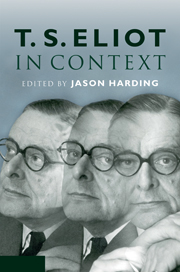Book contents
- Frontmatter
- Contents
- List of illustrations
- List of contributors
- Acknowledgements
- List of abbreviations
- Introduction
- PART ONE LIFE
- PART TWO FORMS
- PART THREE LITERARY CROSS-CURRENTS
- 16 Allusion: the case of Shakespeare
- 17 Classics
- 18 Dante
- 19 Seventeenth-century literature
- 20 Romantic and Victorian poetry
- 21 French poetry
- 22 Georgian poetry
- 23 Bloomsbury
- 24 Ezra Pound
- 25 The avant-garde
- PART FOUR POLITICS, SOCIETY AND CULTURE
- PART FIVE RECEPTION
- Further reading
- Index
16 - Allusion: the case of Shakespeare
Published online by Cambridge University Press: 05 August 2012
- Frontmatter
- Contents
- List of illustrations
- List of contributors
- Acknowledgements
- List of abbreviations
- Introduction
- PART ONE LIFE
- PART TWO FORMS
- PART THREE LITERARY CROSS-CURRENTS
- 16 Allusion: the case of Shakespeare
- 17 Classics
- 18 Dante
- 19 Seventeenth-century literature
- 20 Romantic and Victorian poetry
- 21 French poetry
- 22 Georgian poetry
- 23 Bloomsbury
- 24 Ezra Pound
- 25 The avant-garde
- PART FOUR POLITICS, SOCIETY AND CULTURE
- PART FIVE RECEPTION
- Further reading
- Index
Summary
Walton Litz has spoken of T. S. Eliot's ‘almost insatiable appetite for allusion’, observing that ‘one of the most striking aspects’ of Eliot's poetic development between 1915 and 1920 was ‘the thickening of conscious, orchestrated allusion’. Litz draws attention to Eliot's ‘A Note on Ezra Pound’ published in 1918, which contrasts the ‘deliberateness’ and the ‘positive coherence’ of Pound's use of allusions to those of James Joyce, ‘another very learned literary artist’, who ‘uses allusions suddenly and with great speed, part of the effect being the extent of the vista opened to the imagination by the very lightest touch’. Desmond MacCarthy was one of the first reviewers to comment upon Eliot's allusiveness. In a 1921 notice of Ara Vos Prec, bracketing Eliot with Pound, MacCarthy observed that ‘The allusions in their poems are learned, oblique, and obscure; the mottoes they choose for their poems are polyglot, the names that occur to them are symbolic … known only to book-minded people’ (Brooker, 31). Noting that Eliot's ‘phrases are frequently echoes’, MacCarthy claimed Eliot was ‘the reverse of an imitative poet’, his echoes were ‘tuned to a new context which changes their subtlety. He does not steal phrases; he borrows their aroma.’
- Type
- Chapter
- Information
- T. S. Eliot in Context , pp. 157 - 168Publisher: Cambridge University PressPrint publication year: 2011
- 2
- Cited by

